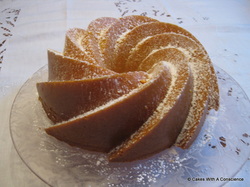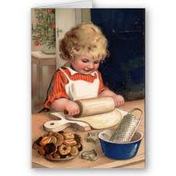
Let me tell you what I've learned about these classic pans (whether they came from Germany in the 1920s or from Ace Hardware in 2013)!
1) Silicone Bundt Pans: You've seen them: they are beautiful and brightly colored and call your name from the shelf, begging you to spend money on one (or more--don't you want one in each color?). Bottom line: If you have one, throw it out, or use it to make aspic or an ice ring for your next batch of party punch (i.e., don't try to bake with it). If you don't have one, don't waste your money. I'll probably hear from the Silicone Pan Protection Society, but the fact is, while silicon is lovely for making candy or jello, or other things that don't have to be baked, they are a nightmare to bake cakes in. Why, you ask? Well, let me tell you! First, from a purely practical point of view, consider the fact that silicone is WOBBLY. Nice if you want to fold it up and shove it in a crowded drawer. But imagine filling said wobbly silicone bundt pan with 10-12 cups of thick and heavy cake batter...and picking it up without smushing or spilling...no, it's not pretty! Yes, you can set it on a baking sheet before you pour and then keep it there to transfer in/out of the oven, but then the presence of the sheet changes the flow of air around the pan. Which brings me to the ultimate fatal flaw of these deadly beauties: they don't heat properly for baking! I am not a science major, but I believe silicone is known for not conducting heat! So, that means when you put a silicone pan filled with cake batter in the oven, what's at the top of the pan (exposed to air) and what's several inches down at the bottom of the pan (surrounded by silicone) does not heat in the same way. The result is cake that looks like it's done on top, but is gush at the bottom (even if you leave it in the oven for a VERY long time). And then, when you remove it from the oven, you have a similar problem trying to cool the cake. I let one sit for 5 hours--and the (largely uncooked) stuff at the bottom was still very hot! You can also imagine what happened when (not realizing that what was in the very bottom was not just hot, but still uncooked and gloppy) I tried to turn it out of the pan onto a cake rack (GRRRR). Word to the wise: Let this cooking fad go the way of fashion fads like big shoulder pads and "poodle" perms!
2) Size Matters. Before you use your pan for the first time, use a measuring cup filled with water, and fill your pan to see how many cups it holds (fill it to the rim), no matter what the manufacturer says about the capacity. All 9" pans do NOT hold the same amount! My grandmother's pan is 9" in diameter and easily holds 15 cups. Nordic Ware's Swirl pan (shown above) and Bavaria are also 9" in diameter, but the Swirl holds 10 C, nearly 1 cup more than their Bavaria, though both claim to hold 10 C. I have another "Classic" pan of unknown provenance, also 9", which might hold 10 C, but the center tube is slightly lower than the outer edge of the pan, so the water spills out before it "fills" the pan. Hmmm! In my experience, most scratch bundt or pound cake recipes make about 8-9 C of batter; some will tell you to use a 12 C pan and likely make about 10 C batter. In order to get all the design elements of the pan when the cake rises, the pan should be filled about 2/3 full. So plan accordingly. I always have spare 1C "mini" bundt pans handy so I don't waste any excess batter (or am tempted to overfill the main pan). It's also a nice way to have a cute little "test cake" or two, if you are trying out a new recipe. Keep in mind that the "minis" will take only about 20 min to bake (so, if you only have a single oven, bake them first so you won't disturb the large cake by opening the oven mid-way through baking)!
3) Recipes Matter. When I first started baking in earnest, I thought any bundt or pound cake recipe would work in any bundt pan...Just grease and flour the pan well and you're good to go, right? WRONG! I soon found that certain recipes are suited to some pans, and not others. Take that beautiful swirl pan above. My Orange Sunrise Pound turns out with clean sharp edges every time in that pan. But when I tried Gram'mom's pound cake recipe in the swirl, it came out with "lacy" edges no matter how I prepped the pan. Chastened after the 4th try, I poured the batter into her pan, and voila! Perfect! If you have a classic (rounded) bundt pan or a classic Guglehopf pan like my grandmother's, then you can probably successfully make most bundt cake recipes in your pans. But "fancy" pans with lots of detailing (like the Bavaria, Fleur de Lis, Cathedral, Rose "petal" or pans with delicate edges) are not as forgiving; the recipe can make a difference between success or, well, "mistake cake". So when you buy a new pan (or try a new recipe), practice once or twice before you make that special-event cake--and trust me, your loved ones and close friends will love you for these experiments. In my experience, thinner batters tend to work better in pans with a lot of intricate detail (e.g. Bavaria); cakes with a bit more shortening work better in pans with long sharp edges (like the Swirl); heavy batters (like a pound cake) work best in "classic" shape pans; and batters with filling (for those of you who really want to make that iconic tunnel-of-fudge cake), pans with smooth rounded shapes and shorter sides will work best, since these cakes tend not to rise as much.
4) Science Matters. What, you ask? Yes, baking is science (just ask Alton Brown)! Ratios of fats, proteins and sugars; chemical reactions when you combine ingredients; and baking temperatures all make a difference in how your cake turns out. But, more on that in an upcoming post! Stay tuned!



 RSS Feed
RSS Feed